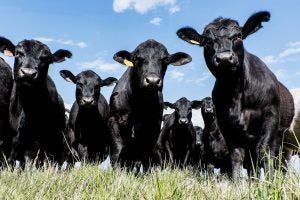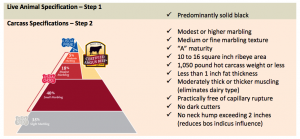It’s no surprise that people may wonder whether the Certified Angus Beef branding has value or if it’s built around meaningless marketing
Amid all the food labels that surround us every day, I often wondered: What does “Certified Angus Beef” actually mean?
We see this all the time, mostly on fast food commercials and advertisements that want to brag about Certified Angus Beef for their burgers or steaks. But throughout the years, I have heard that this label doesn’t always mean that it’s actually Angus. But is this true?
When you think of Angus, you probably think of the commonly delicious breed shown here:

Black Angus is the most common breed of beef cattle in the United States, with 332,421 animals registered in 2017. In 2014, the British Cattle Movement Service named Angus the UK’s most popular native beef breed, and the second most popular beef breed overall.
As for Certified Angus, I wanted to separate fact from fiction — what I’ve heard people say from what the reality is.
For example, I have heard that to qualify as Certified Angus, the cattle only have to have specs of black on their hide. I’ve heard that 10 percent of the hide must be black. I’ve heard they MUST be 100 percent Angus to be certified. Some people say they have to be at least 51 percent black, some say they only have to have a few speckles of black. Some say Holsteins can make the cut, some say they can’t. Some say that as long as the cattle “herd” is at least 50 percent black, they can all be considered black Angus.
What gives? What are the real facts?
And why is there so much conflicting, confusing info? Is there truth in this label that it does mean what it says it means? To help, this link explains the difference between branding marketed as Angus, compared to the Certified Angus breed.
In short, there is definitely some truth to the Certified Angus Beef branding and that the cattle must be predominantly black. The Holstein thing is a myth — they cannot be certified Angus. Angus cattle must be primarily black, and a majority naturally are anyway.
When cattle go to market, every single one is inspected. USDA employees properly trained in cattle will stamp the hide and monitor the oversight of the program. Cameras are also usually installed to maintain the proper grading. Not all Angus can qualify for the top tier of certification! This infographic further explains the animal and carcass specifications.

Ask anyone in the beef world and they’ll tell you that the Angus breed has done a great job marketing themselves as the best. Do other breeds even get to compare? If you did a blind taste test, many would argue there is not much difference in flavor or quality of breed whether Angus or any other breed. As usual, it’s marketing. At least you can be rest assured that if your beef is labeled Certified Angus Beef, there’s a very good chance that it actually is, so you can enjoy your juicy Angus burger or steak with confidence.
Michelle Miller, the Farm Babe, is an Iowa-based farmer, public speaker, and writer, who lives and works with her boyfriend on their farm, which consists of row crops, beef cattle, and sheep. She believes education is key in bridging the gap between farmers and consumers.



